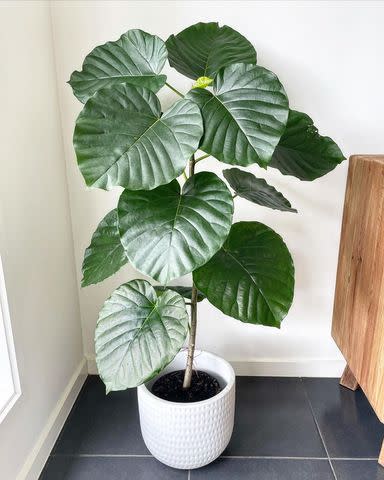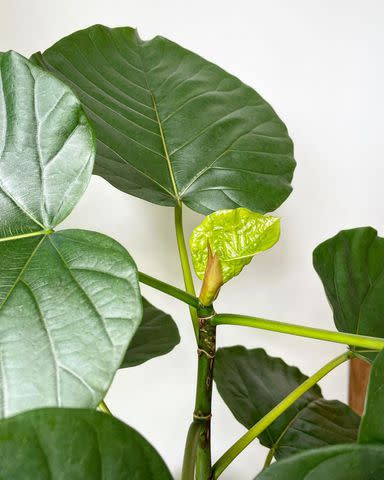How to Grow and Care for Ficus Umbellata
Ficus umbellata is a somewhat unknown species of ficus that has started to gain popularity as a houseplant over the past couple of years. In particular, it’s become a staple in homes across Japan where it’s revered for its large leaves and whimsical appearance, which has led to the common nickname “umbrella tree fig.”
Like its relative the fiddle leaf fig, ficus umbellata grows large, waxy leaves on a thin trunk. Its leaves are heart-shaped and slightly thinner than a fiddle leaf fig’s leaves, with long, delicate petioles. The resulting look is delicate and somewhat ethereal—a fantastic addition to any houseplant collection.
If you’ve grown a ficus before you will have no problem caring for the ficus umbellata. It enjoys a bright spot, regular watering, and warm temperatures and is not picky about fertilization or pruning. Like all plants in the ficus genus, the umbellata is considered toxic to pets and humans if consumed.
Here’s everything you need to know about growing the ficus umbellata as a houseplant.
Common Name | Umbrella tree fig |
Botanical Name | Ficus umbellata |
Family | Moraceae |
Plant Type | Tree, perennial |
Mature Size | 12 ft. tall, 5 ft. wide (indoors) |
Sun Exposure | Full, partial |
Soil Type | Moist but well-draining |
Soil pH | Acidic |
Bloom Time | Doesn't bloom indoors. |
Flower Color | Doesn't bloom indoors. |
Hardiness Zones | 9-11, USDA |
Native Area | Africa |
Toxicity | Toxic to pets, toxic to humans |
Ficus Umbellata Care
Here are the main care requirements for growing Ficus umbellata:
Provide it with plenty of bright, indirect sunlight.
Allow the top few inches of soil to dry out between waterings.
Pot in a loose, well-draining soil mix.
Keep in warm, humid conditions.

@happyplantsofbyron / Instagram

@happyplantsofbyron / Instagram
Light
One of the most important factors when caring for the ficus umbellata is ensuring it has enough light. Like most ficus, the umbellata enjoys plenty of bright, indirect light. This means it should be positioned within a few feet of a bright window. Just be sure to keep it out of harsh, direct sunlight as prolonged periods of direct light can burn the plant’s leaves.
Soil
Ficus umbellata should be planted in a soil mix that retains some water but still drains well. A combination of equal parts indoor potting soil, perlite, and orchid bark mix is a great choice. Alternatively, you can use a cactus and succulent potting mix.
Water
This ficus appreciates consistent moisture but is sensitive to overwatering. Allow the soil to dry out about 25% between waterings and then water thoroughly, allowing the excess water to drain from the pot. Never allow your umbellata to sit in wet soil as it is susceptible to root rot.
Temperature and Humidity
Like most ficus, the umbellata does best in above-average humidity and warm temperatures which makes it ideal for indoor growing. It is not frost-tolerant. If possible, keep humidity above 50% and temperatures between 65% to 85%.
Fertilizer
Regular fertilization during the active growing season is beneficial to the ficus umbellata. In spring and summer, apply a balanced houseplant fertilizer once a month during watering to encourage strong, healthy growth.
Pruning
Pruning isn’t required when caring for a ficus umbellata, but it’s an option if you’re looking to control its size or shape as it matures. Pruning helps encourage the tree to branch and will give it a fuller appearance over time. If you do plan on pruning your ficus, ensure that you wait until spring or summer when the plant is actively growing. Follow the rule of thirds for pruning to keep your umbellata healthy and happy long-term. Also, always use sharp, freshly cleaned pruning shears or scissors so you don’t accidentally introduce any bacteria or disease to the plant once it’s cut.
Propagating Ficus Umbellata
Propagating ficus umbellata is a great way to repurpose trimmings from pruning, or simply grow new plants to share with friends and family. Rooting branch/stem cuttings in water is the easiest way to propagate this ficus. Before you get started, you’ll need a pair of pruning shears or scissors, a vase or jar, some water, a pot, and some well-draining potting soil. Then, follow these instructions:
Using a pair of sharp, clean pruning shears or scissors, take a cutting from a healthy ficus umbellata that has between three to five nodes and at least one leaf.
Remove the bottom couple of leaves from the cutting as the bottom of the stem will be submerged in water.
Fill the vase or container with room temperature water and place the cutting in the water, ensuring at least one node is submerged.
Place the vase in a warm location that gets bright, indirect light. Refresh the water once a week. The cutting should begin to root within a couple of weeks.
Once the roots are sprouted and established the plant can be moved from water to soil. This usually takes between one to two months.
Fill a pot with a well-draining soil mix and plant the rooted cutting, patting the soil down firmly around it.
Water the freshly planted cutting thoroughly and keep the soil evenly moist for the first one to two weeks to help the roots acclimate from water to soil.
Potting and Repotting Ficus Umbellata
This ficus only needs to be repotted once it has grown out of its old pot, and it doesn’t mind being slightly rootbound. This means you’ll probably only need to repot it once every two to three years, depending on its growth rate. If you notice roots growing from the pot’s drainage holes or circling the inside of the pot this is a sign that your plant is ready for a new pot.
As with most houseplants, it’s best to wait until spring or summer to repot, when the plant is actively growing. Ensure that you choose a new potting container that is only two to four inches larger than the previous pot to avoid accidentally overwatering the plant. Then, remove the plant from its pot, shake out as much of the old soil as you can, and plant it in its new container with plenty of fresh potting soil. Water it thoroughly before returning it to its original location.
If you notice your plant develops a few yellow leaves after repotting don’t worry—it’s just adjusting to its new environment. Once it recovers from the shock it should resume growing normally.
Common Pests and Plant Diseases
Ficus umbellata is susceptible to a few common houseplant pests and diseases. In particular, keep an eye out for sap-sucking pests like mealybugs and scale who enjoy this plant’s milky sap. This ficus is also susceptible to root rot, which usually results from overwatering. If you notice your plant losing leaves rapidly or developing mushy stems you may be dealing with root rot.
Common Problems With Ficus Umbellata
While the care requirements for this ficus may be straightforward, it can be picky about its environment, just like its cousin the fiddle leaf fig. If you notice any of the following common problems, it’s usually a sign that your plant is unhappy with its lighting, watering, or temperature and humidity.
Yellow Leaves
The occasional yellow leaf is usually nothing to worry about, but if your plant is rapidly developing yellow leaves there’s probably something more serious going on. Yellow leaves can be a sign that your plant is not getting enough light, is experiencing underwatering or overwatering, or is not getting enough humidity.
Brown Leaves
Similarly, if your plant is developing leaves with brown, crispy spots, it’s probably experiencing stress in its environment. Underwatering and a lack of humidity are the most likely culprits, however, it could also be leaf burn from too much sunlight.
Frequently Asked Questions
Is the ficus umbellata rare?
Most nurseries aren’t mass-producing the umbellata yet since demand isn’t high in North America, but the umbellata isn’t necessarily considered rare. You may have to check out some specialty nurseries or order it online but it will be affordable when you do find it.
Can ficus umbellata handle full sun?
Ficus umbellata prefer bright, indirect sunlight but can handle short periods of direct sunlight as well, particularly if it's morning or evening light. It's best to avoid harsh afternoon sun if possible.
How big does a ficus umbellata get?
Indoors these trees normally grow to be about 10 to 12 feet tall at the most. You can manage their size by pruning regularly or keeping the plant in a smaller pot to limit its growth.
Read Next: How to Grow and Care for Ficus Shivereana
